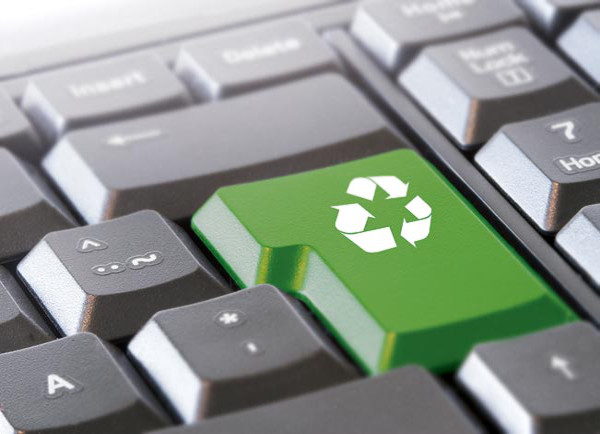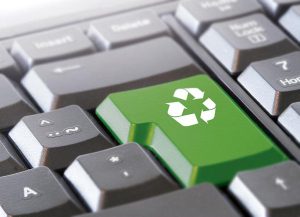“From having repairs cost more than replacement products, to aesthetic upgrades that frame older product versions as less stylish – goods makers have no shortage of ruses to keep opening customers’ wallets.” – Adam Hadhazy
What is low-impact IT?
A lot of energy goes into making our computers, so we think it’s a good idea to make them last as long as possible. Big software companies are always bringing out new software that almost always requires more processing power than its predecessors, and therefore requires more powerful hardware, so tends not to work too well on older computers. This results in criminally short lives for most computers. They can be recycled / made to last longer by a combination of a) a bit of tinkering, and b) using free / open source software and operating systems, which tend to require less processing power.

The Apple II computer.
First, a bit of history, to show the scale of the problem, and the spectacular rise in numbers of computers. In the beginning, only large companies, universities and government agencies had the resources to buy and maintain large mainframe computers. With the development of the microchip, the personal computer appeared in the 1970s and became an affordable tool for the ordinary person, although you still had to build them from kits.
Developments such as the mouse and the graphical user interface were pioneered at Xerox PARC in Palo Alto, USA and by 1977 these innovations could be seen in the Apple II and its competitors. IBM introduced a personal computer to the market in 1981, running Microsoft’s MS-DOS operating system. With their huge established distribution network, they quickly attained world dominance and to this day IBM ‘clones’ have around 95% of the global market, with the remaining 5% being Apple (Macs – the designer’s favourite).

Motherboard with connector slots.
The World Wide Web first appeared in 1992, allowing people to hyperlink pages of information, and with the laying of fibre-optic cables in the late 90s, it became possible to deliver content such as video, real-time chat and 3D. This century has seen the deployment of wireless networks, allowing mobile computing to become a reality, and we are currently at the stage where the computer is shrinking to the size of a mobile phone. All these innovations have propelled a much wider adoption of PCs / smartphones in people’s work and social lives.
Tour of the components of a laptop, and what they do.
What are the benefits of low-impact IT?
With well over 2 billion PCs in the world, and rising rapidly, their short lives point to a massive environmental disaster.
The huge amounts of water, minerals and electricity required to manufacture computer chips mean that the earth’s resources are being depleted unnecessarily. Recycling slows down this process. Some machines are stripped down to their raw materials in India and China and sold back to manufacturers, but it’s more efficient to recondition and donate or sell cheaply to the developing world, opening up computer education and the web to people who can’t afford a new PC. The same applies to disadvantaged children in the West.

Ribbon cable with connector points.
Computer owners tend to upgrade every 3-4 years on average. Some are sold second-hand and some are dumped in landfill, as they’re perceived as having no function beyond their time of currency. Not only is this a waste of good electronic components and precious materials, but over time these same things create highly toxic run-off than can infiltrate the water table. Even if they’re sold on, it requires new resources, manufacturing, transport and all the associated pollution problems to produce new computers.
Reuse is a far better option. The majority of users utilise only 20% of a computer’s functionality. By replacing broken components and installing free / open source software, many computers can become fully functional for many more years at very little cost. These can be good first machines for children as well as elderly people unaccustomed to computing. Another major use is to turn them into servers that can hold your data at a secure and/or remote location and act as a secure gateway to the internet.
What is a Raspberry Pi?
What can I do?
Most importantly, don’t chuck your old computer away. You can have a go at revamping it yourself, with the aforementioned tinkering/open source, or you can give it to specialist companies who recycle them, often for the developing world (see our links page).
If you’re tinkering, you need to learn what the standard components are inside a computer. The motherboard has various slots for memory and external devices such as the power supply, hard disk and graphics / audio cards. Once you’ve been shown, it’s very easy to hook up all the components – similar to sticking Lego blocks together when you were a child – a task achievable within 10 minutes as they all use slot connectors. You might require a pair of thin-nose pliers to adjust the jumpers for the hard disk, but no other tools are necessary.

Much of the world’s computer waste is sent to countries like Ghana, where tens of thousands of people trawl through dumps to extract components, exposed to toxic chemicals and the smoke from plastics being burnt to recover metals.
If some item is not working you can find replacements for little or no cost by cannibalising family and friends’ old machines or buying parts at local computer fairs. It would be unusual to pay more than £30 for a complete set of components and devices to get you up and running. Individual components are sold for £3-£5 each at fairs. You also have to install the correct type of RAM for the processor you have (there are tables available to look up) and install as much as you can, as it will help the machine and software to run faster.
You can find the manual for any computer model online, so you can familiarise yourself with it and have a go at repairing it if required – or take it to a local repair shop. It’s usually not necessary to buy a new computer. Here’s some more on keeping your laptop alive longer.
Beginners’ guide to the connectors on a motherboard.
So that’s the tinkering part. The second part is free software. If you try to install a more modern version of the Windows operating system on an old machine it may well not work due to the hardware not being powerful enough to run the software. Microsoft Windows updates require you to purchase a licensed copy of the software, and often necessitate the purchase of a new machine to cope with the bloated complexities of each new version. They also terminate technical support for each version after a few years, which ‘encourages’ users to buy newer versions just for the added support.
A simpler solution is to erase the hard disk and install a Linux operating system, which will put far less demand on the hardware. It’s important to select the appropriate version of Linux that will run well on your hardware. Debian is good for older machines, Ubuntu for a familiar interface, and Fedora for its simplicity and flexibility on machines with higher performance processors. You can download them free online. Their great advantage is that they’re backward compatible and will run on old machines.

Ubuntu is one of the most popular Linux distributions.
Better still is a full set of free / open source programs that will run on these operating systems. You can download Linux Ubuntu, plus office suite, graphics editor, DTP package and web design programs all for free. The equivalent cost would be several hundred pounds for the same type of software running on Windows.
If you go to our free & open source software page, there are links to tutorials on switching to free / open source operating systems and software. They’re accessible to non-geeks, and you can post queries if you get stuck.

Raspberry Pi mini-computer.
The development of smaller and less power-hungry processors has meant that microcomputers now present a useful alternative to traditional computers. These are small (credit-card-sized) computers that run a Linux operating system, running versions of most open source software. Raspberry Pi is the best known of these, built by the Raspberry Pi Foundation charity.
Thanks to Paul Mobbs of Free Range Activism for information.



6 Comments
Am intrigued as just about to upgrade a 10yr old laptop due to windows vista not supporting Norton antivirus or Firefox browser anymore. Would the operating systems above support an internet browser and antivirus software? Because they are the main barriers for me retaining my old laptop; I generally only use my machine for internet and word processing.
Hi Emma. I used the links in the free & open source software page – https://www.lowimpact.org/lowimpact-topic/free-open-source/ – to install Linux Mint – over a year ago now. It doesn’t need antivirus software – haven’t had a single problem. I’m non-technical by the way – the instructions are written for non-geeks, and I did it successfully).
You can run anything that you can run on Windows – it’s faster and easier. If you only use it for internet and word processing, just download Firefox and Libre Office – but there are links to instructions for all kinds of software from the free/open source software page too. Good luck.
Hi Dave,
Thanks for the response – sorry I didn’t reply sooner. Got tied up with a couple of things so just getting round to looking at the laptop now! That’s really encouraging to hear, it sounds pretty straightforward and I think I’d be confident having a crack at that first before I look at new machines. ??
Emma, I installed Ubuntu, just search for that word and you’ll find the homepage and plenty of instructions. It comes with firefox and LibreOffice as standard. I’ve never had any problems with viruses and the operating system is more secure in the first place. It also has a software downloading tool that gives you a directory of all free software available and that is all checked by Ubuntu elves to check it is not dodgy. Also look up KDE software for calendar organiser things, video editing and all sorts of other stuff. The Ubuntu forums are also great for getting help on any issues.
That’s great nina, thanks for the info. I don’t have too much spare time so I’m still busy backing up files I don’t want to lose to a usb, before I start to look at the O.S. I’ll definitely have a look at Ubuntu – sounds good!
I should have pointed out that if you put Ubuntu on a memory stick, get get your PC to boot from the memory stick, you can use it as a temporary version. It removes any files you created once you log out but it gives you a chance to try it.